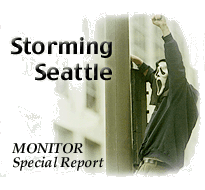
What is Netwar?
by Paul de Armond
 |
by Paul de Armond |
|
The
Direct Action Network's strategy is a classic example of "netwar" conflict. Netwar is a concept introduced in the early 1990's by two researchers at the RAND corporation, a government-funded think tank which began under the auspices of the U.S. Air Force. In a now-seminal paper titled "Cyberwar is Coming!", RAND analysts David Ronfeldt and John Arquilla proposed a new framework for viewing conflict in the information age. The essence of netwar is the emerging forms of conflict in which one or more of the major participants consist of networks, rather than institutions. The central feature of informational conflicts is the struggle for understanding and knowledge, as opposed to more traditional conflicts which focus on controlling territories or resources.
Netwar conflicts are struggles for understanding and information. The FBI fantasies of violent terrorists directing the protests blinded and disabled the police. The more inaccurate the assessment of opposing forces, the greater the advantage to the side which possesses "topview" -- comprehensive and realistic understanding. Netwar is inherently less violent than other forms of conflict, particularly when it involves non-governmental organizations dedicated to human rights and peace causes. One of the first full-blown manifestations of netwar was the Zapatista conflict in Chiapas. The networked intervention of international groups placed very real limits on the use of violence by the Mexican government in supressing the insurrection. In the case of the Direct Action Network, the central prize consisted of the understanding that the WTO multi-lateral trade agreements are intensely corrosive to democracy, at least that form of democracy which entails a knowledgeable public participating in policy formation in meaningful ways.
|
|
Netwars
are fought by networks; collections of groups and organizations guided by non-hierarchical command structures which communicate through "all-points" communications channels of considerable bandwidth and complexity which had global reach via the internet. Institutions, such as police and the AFL-CIO, tend to depend on narrow communications channels which are highly centralized and hierarchical.
Networks operate by "swarming" their opponents, approaching stealthily and from many directions in offense and reacting much like anti-bodies in defense. In netwar, the line between offense and defense can be blurred, leaving opponents unclear about what is occurring and how to respond. Throughout the protests, the Direct Action Network were able to offensively swarm their opponents repeatedly, as shown by the seizure of key intersections on Tuesday and the easy penetration of the "no-protest" zone on Wednesday. The anti-body defense was shown when crowds moved towards police attacks or mass arrests and when numerous groups within the AFL-CIO rally and parade successfully resisted efforts by the union leadership to keep them from supporting the DAN blockade of the WTO convention site. The network form of organization is particularly robust in the face of adversity. The decentralized command and control structure allows rapid shifts of strategic targeting, resistance to "decapitation" (attacks which target leadership), and the disruption of communication channels. All three of these feature were present during the WTO protests. The diffuse communications network allowed all participants to continuously adapt to changing conditions. The consultative form of decision-making enhanced the ability to coordinate large-scale actions. Thus attempts to arrest "ringleaders" on Wednesday were fruitless, since leadership was widely shared throughout the network of protest groups. The communications network was continuously being expanded and modified. On Tuesday, police cut off many of the Direct Action Network communications channels, but in a few hours a new and larger network was functioning.
Albion Monitor
February 29, 2000 (http://www.monitor.net/monitor) All Rights Reserved. Contact rights@monitor.net for permission to use in any format. | ||||||||